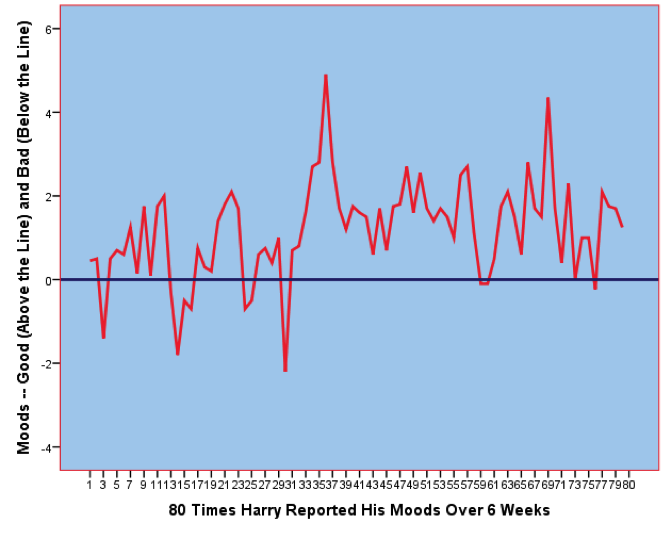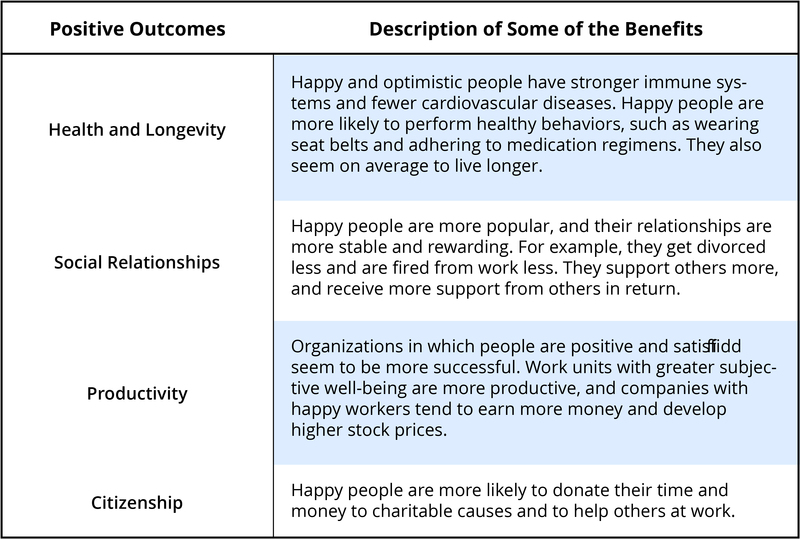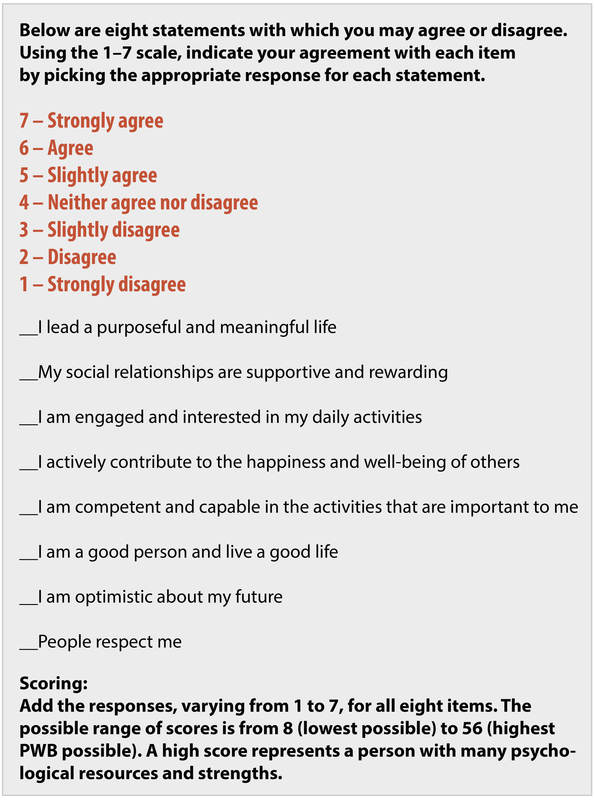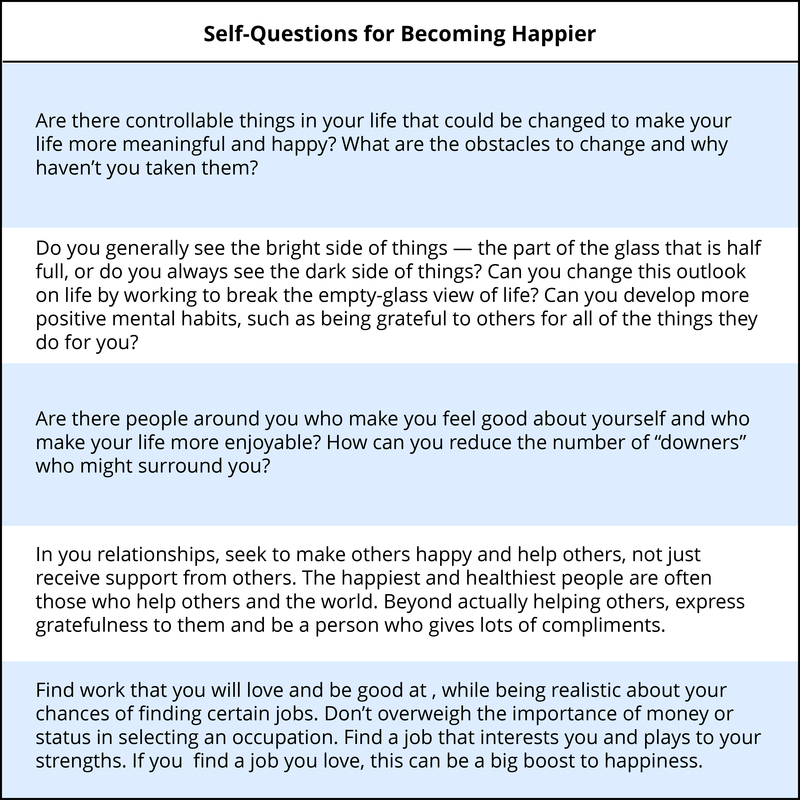Happiness: The Science of Subjective Well-Being
By Edward Diener, University of Utah, University of Virginia
Subjective well-being (SWB) is the scientific term for happiness and life satisfaction—thinking and feeling that your life is going well, not badly. Scientists rely primarily on self-report surveys to assess the happiness of individuals, but they have validated these scales with other types of measures. People’s levels of subjective well-being are influenced by both internal factors, such as personality and outlook, and external factors, such as the society in which they live.
Some of the major determinants of subjective well-being are a person’s inborn temperament, the quality of their social relationships, the societies they live in, and their ability to meet their basic needs. To some degree people adapt to conditions so that over time our circumstances may not influence our happiness as much as one might predict they would. Importantly, researchers have also studied the outcomes of subjective well-being and have found that “happy” people are more likely to be healthier and live longer, to have better social relationships, and to be more productive at work. In other words, people high in subjective well-being seem to be healthier and function more effectively compared to people who are chronically stressed, depressed, or angry. Thus, happiness does not just feel good, but it is good for people and for those around them.
If you had only one gift to give your child, what would it be? Happiness?

When people describe what they most want out of life, happiness is almost always on the list, and very frequently it is at the top of the list. When people describe what they want in life for their children, they frequently mention health and wealth, occasionally they mention fame or success—but they almost always mention happiness. People will claim that whether their kids are wealthy and work in some prestigious occupation or not, “I just want my kids to be happy.” Happiness appears to be one of the most important goals for people, if not the most important. But what is it, and how do people get it?
In this article I describe “happiness” or subjective well-being (SWB) as a process—it results from certain internal and external causes, and in turn it influences the way people behave, as well as their physiological states. Thus, high SWB is not just a pleasant outcome but is an important factor in our future success. Because scientists have developed valid ways of measuring “happiness,” they have come in the past decades to know much about its causes and consequences.
Types of Happiness
Philosophers debated the nature of happiness for thousands of years, but scientists have recently discovered that happiness means different things. Three major types of happiness are high life satisfaction, frequent positive feelings, and infrequent negative feelings (Diener, 1984). “Subjective well-being” is the label given by scientists to the various forms of happiness taken together. Although there are additional forms of SWB, the three in the table below have been studied extensively. The table also shows that the causes of the different types of happiness can be somewhat different.

You can see in the table that there are different causes of happiness, and that these causes are not identical for the various types of SWB. Therefore, there is no single key, no magic wand—high SWB is achieved by combining several different important elements (Diener & Biswas-Diener, 2008). Thus, people who promise to know the key to happiness are oversimplifying.
Some people experience all three elements of happiness—they are very satisfied, enjoy life, and have only a few worries or other unpleasant emotions. Other unfortunate people are missing all three. Most of us also know individuals who have one type of happiness but not another. For example, imagine an elderly person who is completely satisfied with her life—she has done most everything she ever wanted—but is not currently enjoying life that much because of the infirmities of age.
There are others who show a different pattern, for example, who really enjoy life but also experience a lot of stress, anger, and worry. And there are those who are having fun, but who are dissatisfied and believe they are wasting their lives. Because there are several components to happiness, each with somewhat different causes, there is no magic single cure-all that creates all forms of SWB. This means that to be happy, individuals must acquire each of the different elements that cause it.
Causes of Subjective Well-Being
There are external influences on people’s happiness—the circumstances in which they live. It is possible for some to be happy living in poverty with ill health, or with a child who has a serious disease, but this is difficult. In contrast, it is easier to be happy if one has supportive family and friends, ample resources to meet one’s needs, and good health. But even here there are exceptions—people who are depressed and unhappy while living in excellent circumstances. Thus, people can be happy or unhappy because of their personalities and the way they think about the world or because of the external circumstances in which they live. People vary in their propensity to happiness—in their personalities and outlook—and this means that knowing their living conditions is not enough to predict happiness.
In the table below are shown internal and external circumstances that influence happiness. There are individual differences in what makes people happy, but the causes in the table are important for most people (Diener, Suh, Lucas, & Smith, 1999; Lyubomirsky, 2013; Myers, 1992).

Societal Influences on Happiness
When people consider their own happiness, they tend to think of their relationships, successes and failures, and other personal factors. But a very important influence on how happy people are is the society in which they live. It is easy to forget how important societies and neighborhoods are to people’s happiness or unhappiness. In Figure 1, I present life satisfaction around the world. You can see that some nations, those with the darkest shading on the map, are high in life satisfaction. Others, the lightest shaded areas, are very low. The grey areas in the map are places we could not collect happiness data—they were just too dangerous or inaccessible.

Can you guess what might make some societies happier than others? Much of North America and Europe have relatively high life satisfaction, and much of Africa is low in life satisfaction. For life satisfaction living in an economically developed nation is helpful because when people must struggle to obtain food, shelter, and other basic necessities, they tend to be dissatisfied with lives. However, other factors, such as trusting and being able to count on others, are also crucial to the happiness within nations. Indeed, for enjoying life our relationships with others seem more important than living in a wealthy society. One factor that predicts unhappiness is conflict—individuals in nations with high internal conflict or conflict with neighboring nations tend to experience low SWB.
Money and Happiness
Will money make you happy? A certain level of income is needed to meet our needs, and very poor people are frequently dissatisfied with life (Diener & Seligman, 2004). However, having more and more money has diminishing returns—higher and higher incomes make less and less difference to happiness. Wealthy nations tend to have higher average life satisfaction than poor nations, but the United States has not experienced a rise in life satisfaction over the past decades, even as income has doubled. The goal is to find a level of income that you can live with and earn. Don’t let your aspirations continue to rise so that you always feel poor, no matter how much money you have. Research shows that materialistic people often tend to be less happy, and putting your emphasis on relationships and other areas of life besides just money is a wise strategy. Money can help life satisfaction, but when too many other valuable things are sacrificed to earn a lot of money—such as relationships or taking a less enjoyable job—the pursuit of money can harm happiness.
There are stories of wealthy people who are unhappy and of janitors who are very happy. For instance, a number of extremely wealthy people in South Korea have committed suicide recently, apparently brought down by stress and other negative feelings. On the other hand, there is the hospital janitor who loved her life because she felt that her work in keeping the hospital clean was so important for the patients and nurses. Some millionaires are dissatisfied because they want to be billionaires. Conversely, some people with ordinary incomes are quite happy because they have learned to live within their means and enjoy the less expensive things in life.
It is important to always keep in mind that high materialism seems to lower life satisfaction—valuing money over other things such as relationships can make us dissatisfied. When people think money is more important than everything else, they seem to have a harder time being happy. And unless they make a great deal of money, they are not on average as happy as others. Perhaps in seeking money they sacrifice other important things too much, such as relationships, spirituality, or following their interests. Or it may be that materialists just can never get enough money to fulfill their dreams—they always want more.
To sum up what makes for a happy life, let’s take the example of Monoj, a rickshaw driver in Calcutta. He enjoys life, despite the hardships, and is reasonably satisfied with life. How could he be relatively happy despite his very low income, sometimes even insufficient to buy enough food for his family? The things that make Monoj happy are his family and friends, his religion, and his work, which he finds meaningful. His low income does lower his life satisfaction to some degree, but he finds his children to be very rewarding, and he gets along well with his neighbors. I also suspect that Monoj’s positive temperament and his enjoyment of social relationships help to some degree to overcome his poverty and earn him a place among the happy. However, Monoj would also likely be even more satisfied with life if he had a higher income that allowed more food, better housing, and better medical care for his family.

Besides the internal and external factors that influence happiness, there are psychological influences as well—such as our aspirations, social comparisons, and adaptation. People’s aspirations are what they want in life, including income, occupation, marriage, and so forth. If people’s aspirations are high, they will often strive harder, but there is also a risk of them falling short of their aspirations and being dissatisfied. The goal is to have challenging aspirations but also to be able to adapt to what actually happens in life.
One’s outlook and resilience are also always very important to happiness. Every person will have disappointments in life, fail at times, and have problems. Thus, happiness comes not to people who never have problems—there are no such individuals—but to people who are able to bounce back from failures and adapt to disappointments. This is why happiness is never caused just by what happens to us but always includes our outlook on life.
Adaptation to Circumstances
For instance, many people are euphoric when they first marry, but over time they grow accustomed to the marriage and are no longer ecstatic. The marriage becomes commonplace and they return to their former level of happiness. Few of us think this will happen to us, but the truth is that it usually does. Some people will be a bit happier even years after marriage, but nobody carries that initial “high” through the years.
People also adapt over time to bad events. However, people take a long time to adapt to certain negative events such as unemployment. People become unhappy when they lose their work, but over time they recover to some extent. But even after a number of years, unemployed individuals sometimes have lower life satisfaction, indicating that they have not completely habituated to the experience. However, there are strong individual differences in adaptation, too. Some people are resilient and bounce back quickly after a bad event, and others are fragile and do not ever fully adapt to the bad event. Do you adapt quickly to bad events and bounce back, or do you continue to dwell on a bad event and let it keep you down?
An example of adaptation to circumstances is shown in Figure 3, which shows the daily moods of “Harry,” a college student who had Hodgkin’s lymphoma (a form of cancer). As can be seen, over the 6-week period when I studied Harry’s moods, they went up and down. A few times his moods dropped into the negative zone below the horizontal blue line. Most of the time Harry’s moods were in the positive zone above the line. But about halfway through the study Harry was told that his cancer was in remission—effectively cured—and his moods on that day spiked way up. But notice that he quickly adapted—the effects of the good news wore off, and Harry adapted back toward where he was before. So even the very best news one can imagine—recovering from cancer—was not enough to give Harry a permanent “high.” Notice too, however, that Harry’s moods averaged a bit higher after cancer remission. Thus, the typical pattern is a strong response to the event, and then a dampening of this joy over time. However, even in the long run, the person might be a bit happier or unhappier than before.

Outcomes of High Subjective Well-Being
Is the state of happiness truly a good thing? Is happiness simply a feel-good state that leaves us unmotivated and ignorant of the world’s problems? Should people strive to be happy, or are they better off to be grumpy but “realistic”? Some have argued that happiness is actually a bad thing, leaving us superficial and uncaring. Most of the evidence so far suggests that happy people are healthier, more sociable, more productive, and better citizens (Diener & Tay, 2012; Lyubomirsky, King, & Diener, 2005). Research shows that the happiest individuals are usually very sociable. The table below summarizes some of the major findings.

Although it is beneficial generally to be happy, this does not mean that people should be constantly euphoric. In fact, it is appropriate and helpful sometimes to be sad or to worry. At times a bit of worry mixed with positive feelings makes people more creative. Most successful people in the workplace seem to be those who are mostly positive but sometimes a bit negative. Thus, people need not be a superstar in happiness to be a superstar in life. What is not helpful is to be chronically unhappy. The important question is whether people are satisfied with how happy they are. If you feel mostly positive and satisfied, and yet occasionally worry and feel stressed, this is probably fine as long as you feel comfortable with this level of happiness. If you are a person who is chronically unhappy much of the time, changes are needed, and perhaps professional intervention would help as well.
Measuring Happiness
SWB researchers have relied primarily on self-report scales to assess happiness—how people rate their own happiness levels on self-report surveys. People respond to numbered scales to indicate their levels of satisfaction, positive feelings, and lack of negative feelings. You can see where you stand on these scales by going to http://internal.psychology.illinois.edu/~ediener/scales.html or by filling out the Flourishing Scale below. These measures will give you an idea of what popular scales of happiness are like.

The self-report scales have proved to be relatively valid (Diener, Inglehart, & Tay, 2012), although people can lie, or fool themselves, or be influenced by their current moods or situational factors. Because the scales are imperfect, well-being scientists also sometimes use biological measures of happiness (e.g., the strength of a person’s immune system, or measuring various brain areas that are associated with greater happiness). Scientists also use reports by family, coworkers, and friends—these people reporting how happy they believe the target person is. Other measures are used as well to help overcome some of the shortcomings of the self-report scales, but most of the field is based on people telling us how happy they are using numbered scales.
There are scales to measure life satisfaction (Pavot & Diener, 2008), positive and negative feelings, and whether a person is psychologically flourishing (Diener et al., 2009). Flourishing has to do with whether a person feels meaning in life, has close relationships, and feels a sense of mastery over important life activities. You can take the well-being scales created in the Diener laboratory, and let others take them too, because they are free and open for use.
Some Ways to Be Happier
Most people are fairly happy, but many of them also wish they could be a bit more satisfied and enjoy life more. Prescriptions about how to achieve more happiness are often oversimplified because happiness has different components and prescriptions need to be aimed at where each individual needs improvement—one size does not fit all. A person might be strong in one area and deficient in other areas. People with prolonged serious unhappiness might need help from a professional. Thus, recommendations for how to achieve happiness are often appropriate for one person but not for others. With this in mind, I list in Table 4 below some general recommendations for you to be happier (see also Lyubomirsky, 2013):

References
- Diener, E. (1984). Subjective well-being. Psychological Bulletin, 95, 542–575.
- Diener, E., & Biswas-Diener, R. (2008). Happiness: Unlocking the mysteries of psychological wealth. Malden, MA: Wiley/Blackwell.
- Diener, E., & Seligman, M. E. P. (2004). Beyond money: Toward an economy of well-being. Psychological Science in the Public Interest, 5, 1–31.
- Diener, E., & Tay, L. (2012). The remarkable benefits of happiness for successful and healthy living. Report of the Well-Being Working Group, Royal Government of Bhutan. Report to the United Nations General Assembly: Well-Being and Happiness: A New Development Paradigm.
- Diener, E., Inglehart, R., & Tay, L. (2012). Theory and validity of life satisfaction scales. Social Indicators Research, in press.
- Diener, E., Suh, E. M., Lucas, R. E., & Smith, H. L. (1999). Subjective well-being: Three decades of progress. Psychological Bulletin, 125, 276–302.
- Diener, E., Wirtz, D., Tov, W., Kim-Prieto, C., Choi, D., Oishi, S., & Biswas-Diener, R. (2009). New measures of well-being: Flourishing and positive and negative feelings. Social Indicators Research, 39, 247–266.
- Lyubomirsky, S. (2013). The myths of happiness: What should make you happy, but doesn’t, what shouldn’t make you happy, but does. New York, NY: Penguin.
- Lyubomirsky, S., King, L., & Diener, E. (2005). The benefits of frequent positive affect: Does happiness lead to success? Psychological Bulletin, 131, 803–855.
- Myers, D. G. (1992). The pursuit of happiness: Discovering pathways to fulfillment, well-being, and enduring personal joy. New York, NY: Avon.
- Pavot, W., & Diener, E. (2008). The Satisfaction with life scale and the emerging construct of life satisfaction. The Journal of Positive Psychology, 3, 137–152.

Ed Diener, Senior Scientist for the Gallup Organization and professor atthe University of Virginia and University of Utah, received three of the highest honors in psychology (APA’s Distinguished Scientist Award, the APS William James Award, and election to the American Academy of Arts and Sciences) for his groundbreaking research on happiness.
Creative Commons License

